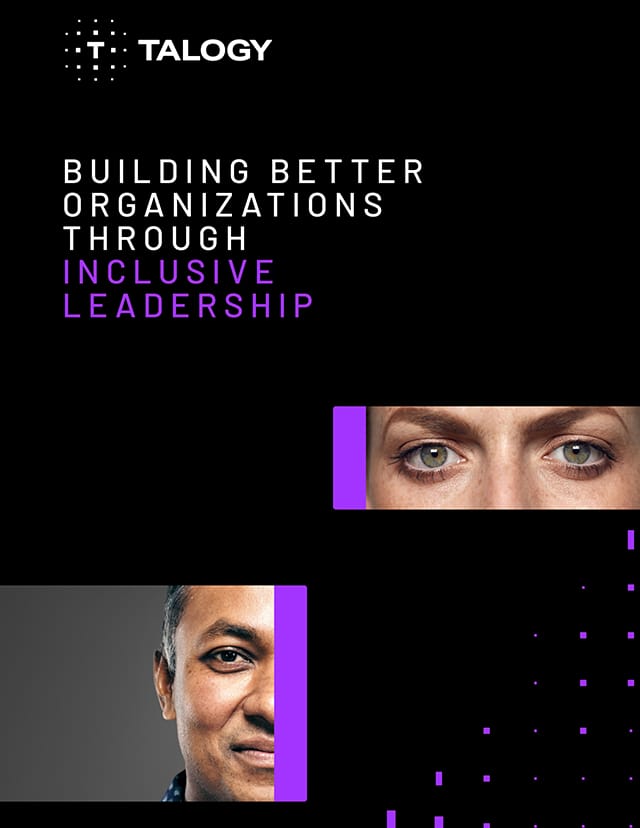Written by Ali Shalfrooshan, Head of International Assessment R&D
The topic of diversity and inclusion is one that has reverberated around workplaces over the last few years. While the conversation is typically very positive it can also lead to some misconceptions and in some cases, frustrations regarding its purpose. The truth is diversity and inclusion is a people strategy designed to help everyone and is ultimately focused on creating a foundation of belonging. Regardless of people’s perspectives on the topic and the lens through which they view it, embracing diversity in all of its forms has been shown to be vital to organisational success. But what is the key to effectively embracing differences in the workplace? Keep reading as we explore the importance of the core behaviours needed for organisations to fully embrace diversity and inclusion.
The organisational benefits of a diverse workforce
When organizations embrace differences within their workforce, they not only provide advantages to social groups, but give themselves an advantage over their competition. This is reflected in statistics such as:
- Organisations in the top quartile for gender diversity on executive teams are 39% more likely to outperform peers, continuing an upward trend from 15% in 2015 (McKinsey, 2023).
- Diverse teams make better business decisions up to 87% of the time (Forbes, 2021).
- Organisations in the top quartile for ethnic representation on executive teams also have 39% increased likelihood of outperformance versus those in the bottom quartile (McKinsey, 2023).
However, learning how to embrace diversity and prioritise inclusive behaviours in the workplace is not something that is always easy to manage and cannot be achieved without effort and support from both leaders and employees. The true value of differences can only be made tangible when colleagues work effectively with each other and truly embrace diversity. In some ways it is like a secret superpower we’ve had all along but somehow keep forgetting to use.
Are there challenges when it comes to embracing diversity?
Even though the issue is about enabling everyone to gain a sense of belonging, we still need to address the elephant in the room. Irrespective of how much we have progressed as a society, we still have some challenges around the topic of diversity and inclusion that need to be addressed. According to the Bureau of Labor Statistics, in 2022:
- Women in the US earned 17% less than men on average.
- In 2021, White women earned 82% as much as White men and the gap was even wider for many women of colour.
- Black women earned 69% as much as White men and Hispanic women earned 63%.
Unfortunately, the issues revealed by these numbers are also reflected in recruitment and hiring processes. A meta-analysis of experiments on hiring discrimination published between 2005 and 2020 (Lippens, et al, 2023) found that ethnic minority candidates on average receive nearly 33% fewer positive responses to their applications than their majority counterparts. Additionally, applicants with disabilities receive about 40% fewer positive responses on average.
There are many more examples of inequities still being rife in the workplace such as a lack of diversity in leadership positions, unequal career advancement, lack of disability accommodations, exclusion from informal networks, and examples of direct discrimination. In these cases of outright discrimination, the reality is that at times the root causes of the majority of these systemic issues are due to natural cognitive processes that help us manage information and are relatively benign.
The mind and unconscious bias
Bias surrounds us all. How we perceive the world is not as transparent and clear as we think. Our views and perspectives are all influenced by the prism in which we see the world. This prism is influenced by our upbringing, experiences, and the culture that we are subsumed in. Whatever our gender identity, sexual orientation, socio-economic status, disability status, ethnicity, political affiliation, or personality, all of us – to a greater or lesser extent – have dealt with some form of bias or have been the arbiter of bias toward someone else. In most cases, these biases are not a representation of a malevolent belief; they are just a function of how our brains unconsciously and consciously process information and how we internalise the societal norms we have been exposed to.
The human mind is incredible. It is capable of 1,016 processes per second, and according to the University of Southern California, the average brain generates 70,000 thoughts per day. This highlights the volume of processes and thoughts that our brains must manage when making decisions where, as a consequence, psychologists suggest the use of a range of cognitive strategies called heuristics to address this. This view is made opaque through a range of cognitive processes that help us manage this information in a useful way. These processes prioritise our successful functioning and require simplification of our complex environment and can ultimately lead to bias.
Heuristics are quite broad and can cover a range of cognitive processes. There are so many different heuristics that our brain deploys (recognition heuristics, fluency heuristics, trade off heuristics, social heuristics, etc.). We do not yet fully understand how heuristics explicitly manifest as biases. Nevertheless, they provide a part of the explanation for why bias is something our brains do, despite our intentions typically being well-meaning and inclusive.
The most important factor to focus on is that if we are open to accepting that bias is a component of our brains functioning, we are able to take the first steps to address the fundamental issues at hand to embrace diversity and inclusion. By accepting that we can be biased, we are better able to question ourselves and try to consider how we can proactively improve things. More importantly to fully deliver inclusion, what we do is where the true key lies.
Our behaviour is the core source of the solution
Over the last 10 years, my colleagues and I have been working on understanding how we can help organisations embrace differences within their teams to become more inclusive. This all started with research we carried out to identify the core behaviours anyone can demonstrate that can help employees work effectively with each other irrespective of how similar or different they may be. These inclusive behaviours underpinned an individual’s capability to work fairly, respectfully, and to engage with all types of people regardless of who they are. The aim of this initiative was to address issues of inclusion and exclusion directly by enhancing our understanding of a concept termed as “cultural capability.”
The research was not just focused on differences related to ethnicity alone, it reflected all the areas that we as humans can be different, be it our opinions, sexuality, gender, disability status, or economic status to name a few. Over the past centuries, we have seen all kinds of diversity that has resulted in friction. This friction has been made even more visible by social media. But friction isn’t the enemy – it’s how we handle it that matters.
6 core behaviours for embracing diversity and inclusion
Based on our research, cultivating a set of inclusive behaviours is essential for effectively embracing diversity and creating an inclusive climate where people can work effectively. By nurturing and improving the six inclusive behaviours below, we can foster a culture of inclusivity, learning, and mutual understanding among individuals.
- Empathy: This core behaviour helps us understand and show sensitivity towards others’ perspectives, views, and concerns, regardless of their background. Think of it as taking a walk in someone else’s shoes – or at least trying them on in an effort to understand and care about others’ perspectives, regardless of where they’re coming from.
- Relationship building: We must work effectively to build relationships with people from a wide range of different backgrounds, establishing rapport and trust to exhibit inclusive behaviour at work. People work better when they trust each other, build connections with people from all backgrounds, and be the glue that holds the team together.
- Learning orientation: Exhibiting this core behaviour helps employees seek learning and development opportunities, take steps to fill gaps in skills and knowledge, and be open to new experiences and information. Always be hungry to learn, whether it’s about different cultures, viewpoints, or just how someone prefers their coffee or tea.
- Open-mindedness: This core behaviour ensures that we are tolerant and non-judgmental when dealing with others, avoiding assumptions and preconceptions, treating each individual and situation separately. People are complex and full of surprises – treat them that way as each individual deserves to be seen without judgement.
- Composure: By displaying composure, we show that we are confident and resilient and able to remain calm and controlled in our responses. The workplace can be stressful, but if you show calmness and grace under pressure, you will likely be better able to navigate tensions.
- Flexibility: When we embrace diversity and exhibit inclusive behaviour, we are able to adapt our approach to different individuals, identifying solutions based on their specific needs and background. Not everything fits into neat boxes, so be flexible and adaptable and meet people where they are, not where you think they should be.
This list of inclusive behaviours isn’t just theoretical; these are practical tools needed to help us work better with people who might see the world differently than we do, and in turn embrace our differences. And that’s where the true value of embracing diversity occurs. It’s not about everyone thinking the same or even agreeing on everything. It’s about learning from each other’s perspectives to come up with better solutions.
At the end of the day, it’s our differences – not our similarities – that make us stronger. By embracing diversity and showing up with these core behaviours, we don’t just create a more inclusive workplace, we create a better world for everyone. And who wouldn’t want to be part of that?



